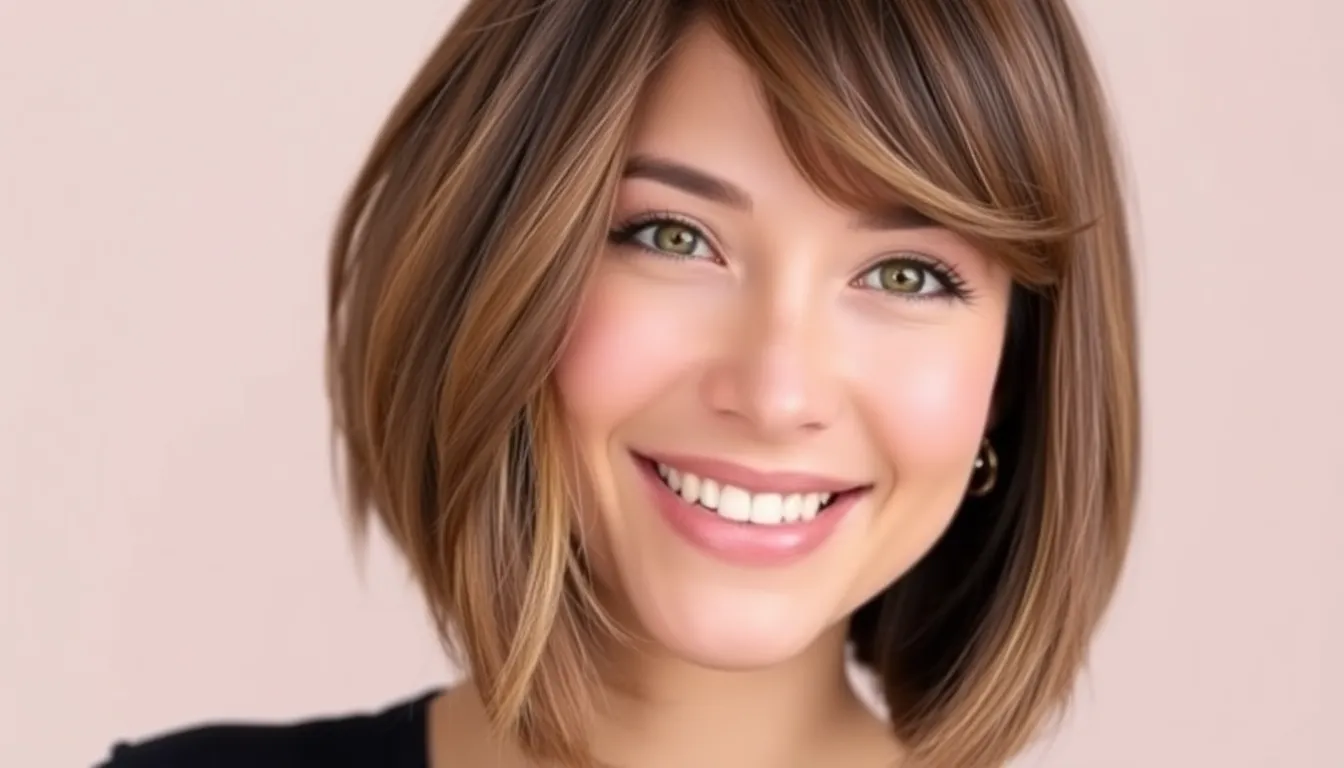We’ve all been there – staring in the mirror wondering how to make thin hair look fuller and more voluminous. The good news? Medium length hairstyles are your secret weapon for creating the illusion of thicker locks while maintaining that perfect balance between short and long.
Medium length cuts offer incredible versatility for thin hair because they’re not too heavy to weigh down your strands yet provide enough length to work with various styling techniques. From strategic layers that add movement to clever texturizing tricks that boost volume these hairstyles can completely transform your look.
We’ve curated five absolutely stunning medium length styles that’ll make your thin hair look like you’ve got twice the volume. Each cut is designed to maximize your hair’s natural texture while giving you that coveted full-bodied appearance you’ve been craving.
The Textured Lob: Adding Volume Through Strategic Layers
The textured lob transforms thin hair through carefully placed layers that create natural movement and dimension. We’ve found this medium length style delivers exceptional volume without sacrificing sophistication.
Creating Movement With Face-Framing Layers
Strategically positioned layers around your face instantly lift thin hair from the roots. Professional stylists recommend starting these layers at chin level to maximize volume distribution throughout the hair shaft. Longer pieces in the back maintain weight while shorter sections create the illusion of fuller density.
Graduation techniques work wonders for adding dimension to fine strands. Your stylist should cut each layer at different angles, creating a cascading effect that prevents hair from lying flat against your scalp. This approach generates natural separation between sections, making individual strands appear thicker and more substantial.
Face-framing elements enhance your facial features while boosting overall volume. Soft layers that curve around your cheekbones and jawline create movement every time you turn your head. These strategic cuts catch light differently, producing visual depth that makes thin hair look significantly fuller.
Styling Tips for Maximum Body and Bounce
Blow drying with a round brush creates lasting lift at the roots. Start by applying volumizing mousse to damp hair, then use a medium-sized round brush to lift sections away from your scalp while directing heat downward. This technique builds body from the foundation up, ensuring your textured lob maintains its shape throughout the day.
Curling sections away from your face amplifies the layered effect dramatically. Use a 1.5-inch curling iron to create loose waves in alternating directions, focusing on the mid-lengths rather than the ends. Allow curls to cool completely before gently finger-combing them for natural-looking texture.
Scrunching techniques enhance the lob’s natural movement and bounce. Apply texturizing spray to slightly damp hair, then scrunch upward from the ends toward the roots. This method encourages your layers to separate and move independently, creating the voluminous appearance you’re seeking.
Best Products for Maintaining Texture
Volumizing mousses provide essential foundation for thin hair styling routines. Look for lightweight formulas containing polymers and proteins that coat each strand without adding weight. Apply these products to towel-dried hair, focusing on the roots and mid-lengths where you need maximum lift.
Texturizing sprays maintain separation between layers throughout the day. Products with sea salt or mineral content create grip and hold without stiffness, allowing your textured lob to move naturally while retaining its shape. Spray these formulas onto dry hair for instant texture enhancement.
Dry shampoos extend your style while adding crucial volume at the roots. Choose powder-based formulas rather than aerosol versions for better oil absorption and lift. Apply dry shampoo to clean hair as a preventative measure, creating texture and grip that helps your layers hold their position longer.
The Blunt Bob With Subtle Waves: Classic Meets Contemporary

Blunt bobs have evolved beyond their traditional sharp edges to incorporate gentle waves that breathe new life into this timeless cut. We’ve discovered that combining the clean lines of a classic bob with soft wave textures creates an ideal medium length solution for thin hair.
Why Blunt Cuts Create the Illusion of Thickness
Blunt cutting techniques instantly make thin hair appear denser by creating clean horizontal lines that stop light reflection uniformly. We recommend maintaining the same length across all sections to maximize visual weight and prevent any uneven areas that might expose scalp visibility. Sharp edges at the perimeter create a solid foundation that tricks the eye into perceiving more hair volume than actually exists.
Professional colorists often pair blunt bobs with strategic highlights to enhance the thickness illusion. We’ve seen clients achieve remarkable fullness when their stylists add subtle babylights throughout the cut, creating depth without compromising the clean line integrity. Precision cutting tools become essential for maintaining those crisp edges that contribute to the voluminous appearance.
The weight distribution in blunt cuts naturally pulls hair downward, reducing flyaways and creating smoother surfaces. We notice that this downward pull helps fine strands lie closer together, eliminating gaps that typically reveal scalp areas in layered styles.
Wave Techniques That Won’t Weigh Down Fine Hair
Beach wave sprays applied to damp hair provide the lightest texturizing option for creating subtle movement in blunt bobs. We recommend using salt based formulas that enhance natural texture without adding heavy moisture that can flatten fine strands. Scrunching techniques work particularly well when applied from mid length to ends, preserving root volume while encouraging gentle bends.
Diffusing becomes crucial for maintaining wave integrity without over manipulating delicate hair. We suggest using low heat settings with the diffuser attachment, gently cupping sections while the hair dries naturally. This method prevents frizz while encouraging organic wave patterns that complement the blunt cut structure.
Velcro rollers offer another lightweight approach for adding soft curves to medium length bobs. We’ve found that using medium sized rollers on slightly damp hair creates lasting waves without requiring heavy styling products. Rolling away from the face in alternating directions produces the most natural looking movement.
Braiding damp hair into loose plaits overnight generates effortless waves that last throughout the next day. We recommend applying a light leave in conditioner before braiding to protect hair integrity while ensuring smooth wave formation.
Maintenance and Touch Up Schedule
Blunt bobs require professional trimming every 6 to 8 weeks to maintain their sharp edge definition and prevent split ends from compromising the clean lines. We schedule appointments based on individual hair growth rates, with faster growing hair needing more frequent maintenance visits. Regular trims become especially important for thin hair because any damaged ends immediately detract from the thickness illusion.
Root touch ups should align with trim schedules when color services are involved in the overall look. We coordinate these appointments to maximize salon efficiency while ensuring consistent color coverage that supports the blunt cut’s visual impact.
At home maintenance involves daily gentle brushing with boar bristle brushes that distribute natural oils without causing breakage. We recommend sleeping on silk pillowcases to reduce friction and preserve wave patterns overnight, extending the time between styling sessions.
Weekly deep conditioning treatments help maintain hair health without weighing down fine strands when applied only to mid lengths and ends. We avoid applying conditioning products near the roots to prevent volume reduction in this crucial area.
The Shag Revival: Effortless Layers for Natural Volume

We’re witnessing a major comeback of the shag haircut, reimagined specifically for those with thin hair who crave natural volume without heavy styling.
Modern Shag Variations for Thin Hair Types
Wolf cuts combine shag elements with mullet inspired layers, creating incredible texture that makes fine strands appear substantially thicker. These cuts feature shorter layers around the crown that gradually blend into longer pieces at the back, giving thin hair maximum lift where it’s needed most.
Curtain bang shags frame the face beautifully while adding strategic volume through feathered layers that start just below the cheekbones. Professional stylists recommend this variation for oval and heart shaped faces, as the soft fringe creates width across the forehead while maintaining movement throughout the mid lengths.
Asymmetrical shags offer an edgier approach with uneven layers that trick the eye into seeing more density. One side typically features shorter choppy pieces while the other maintains longer flowing layers, creating visual interest that distracts from hair’s natural thinness.
Micro shags work exceptionally well for those with extremely fine hair, incorporating tiny graduated layers that begin high on the crown. These subtle cuts add just enough texture to create body without overwhelming delicate strands or creating an overly dramatic look.
Styling Methods for That Perfect Undone Look
Air drying techniques help achieve that coveted effortless shag texture without heat damage that can further thin already delicate hair. We recommend scrunching damp hair with a microfiber towel and applying a lightweight mousse from mid lengths to ends for natural separation.
Diffusing methods enhance the shag’s natural movement while adding controlled volume at the roots. Set your diffuser to low heat and cup sections of hair gently, lifting upward to encourage the layers to fall naturally into place without creating frizz.
Finger styling creates the most authentic undone appearance by separating individual layers while hair is still slightly damp. Simply rake your fingers through each section, twisting small pieces randomly to emphasize the cut’s choppy texture.
Overnight braiding transforms your shag into beachy waves without any styling tools. Braid damp hair loosely before bed and unravel in the morning, then shake out the waves with your fingers for instant tousled volume.
Color Techniques That Enhance the Shag Cut
Balayage highlights strategically placed throughout the layers create depth and dimension that makes thin hair appear significantly fuller. Colorists typically focus lighter tones around the face and on the ends of each layer to emphasize the cut’s movement and texture.
Root shadowing adds darkness at the base while keeping the lengths lighter, creating an optical illusion of thickness from scalp to tips. This technique works particularly well with shags because the varying layer lengths showcase the color contrast beautifully.
Money piece highlighting involves painting bright streaks around the face to draw attention to the shag’s flattering layers. These face framing highlights reflect light and create the appearance of additional strands, making overall hair density seem increased.
Glossing treatments enhance any base color while adding reflective properties that make each individual strand more visible. Professional glosses seal the hair cuticle and create shine that amplifies the shag’s textured appearance, giving thin hair a healthier and fuller looking finish.
The Asymmetrical Bob: Bold Angles for Big Impact

Asymmetrical bobs create stunning visual interest while adding remarkable volume to thin hair through strategic length variation. These edgy cuts work particularly well for fine strands because the uneven lengths prevent hair from lying flat against your head.
Choosing the Right Asymmetrical Style for Your Face Shape
Round faces benefit most from longer front pieces that extend past the jawline on one side while keeping the back shorter. We recommend angling the longer section to graze your collarbone for maximum lengthening effect.
Square face shapes look incredible with softer asymmetrical cuts that feature gentle curves rather than sharp angles. Position the longer side to hit just below your chin while maintaining subtle graduation throughout.
Heart shaped faces work beautifully with asymmetrical bobs that add width at the jawline through strategic layering. Create balance by keeping the shorter side at ear level while extending the longer portion to your shoulders.
Oval faces can embrace the most dramatic asymmetrical styles since this face shape naturally complements bold contrasts. Try extreme length differences with one side reaching your shoulders and the other hitting just below your ears.
Styling One Side Longer Than the Other
Blow dry the shorter side using a small round brush to lift roots and create maximum volume at the crown. Direct airflow upward and away from your scalp to prevent the hair from falling flat.
Curl the longer section in loose waves using a 1.5 inch barrel iron to add body and movement. Wrap sections away from your face and hold for 8 to 10 seconds before releasing for natural looking texture.
Apply texturizing products differently on each side based on length requirements. Use volumizing mousse on the shorter side and lightweight styling cream on the longer portion to maintain balance.
Create separation between the two lengths by tucking the shorter side behind your ear while allowing the longer section to cascade forward. This technique emphasizes the asymmetrical design while adding visual weight to thin strands.
Professional vs. DIY Maintenance Tips
Professional maintenance every 4 to 6 weeks keeps asymmetrical cuts looking sharp and prevents uneven growth from compromising the style’s impact. Skilled stylists can adjust the angle and length ratio to maintain the dramatic effect.
DIY touch ups work best for minor adjustments between salon visits using sharp haircutting shears. Trim only the longest pieces and avoid attempting to reshape the shorter side without professional guidance.
Product maintenance requires different formulations for each side of your asymmetrical bob. Stock lightweight volumizers for the shorter section and smoothing serums for the longer side to optimize both texture and movement.
Growth management becomes crucial as asymmetrical cuts can look unbalanced when growing out. Schedule regular consultations with your stylist to modify the cut’s proportions as your hair lengthens naturally.
The Layered Midi Cut: Shoulder-Length Sophistication

Sophisticated layered midi cuts deliver remarkable volume transformation for those with thin hair seeking professional polish. This shoulder length style combines the elegance of longer cuts with the body boosting benefits of strategic layering.
Strategic Layer Placement for Volume Creation
Layered midi cuts use exact placement techniques to maximize lift and movement throughout thin hair. Professional stylists position long layers starting 2 to 3 inches below the chin to create natural lift without removing excessive weight. Face framing layers begin at cheekbone level and cascade downward to add dimension while preventing the flat appearance common with thin hair.
Graduation angles between 15 to 30 degrees create the optimal volume distribution for midi length cuts. Internal layers are cut slightly shorter than external layers, allowing hair to stack and build upon itself for increased thickness. Corner softening techniques round harsh edges while maintaining the structured shape that gives thin hair its lifted appearance.
Disconnected layering creates movement pockets that add visual density throughout the cut. Point cutting methods remove bulk without sacrificing volume, while slide cutting creates soft transitions between layer levels. These techniques prevent thin hair from falling flat against the head and encourage natural separation that mimics thicker hair texture.
Versatile Styling Options for Day and Night
Daytime styling focuses on creating polished volume that maintains professional sophistication. Blow drying with a paddle brush creates smooth volume at the roots, while round brush techniques add gentle curves to layer ends. Light misting with heat protectant prevents damage during styling while maintaining the cut’s structured shape.
Evening transformations use curling techniques that enhance the midi cut’s natural layer placement. Large barrel curls wrapped away from the face create glamorous volume, while alternating curl directions add movement and prevent uniformity. Finger combing through cooled curls softens the style while maintaining lift at the crown area.
Texture styling methods work exceptionally well with layered midi cuts on thin hair. Scrunching techniques with lightweight mousses enhance natural wave patterns without weighing down fine strands. Air drying with diffuser attachments preserves the cut’s volume while creating effortless movement that appears naturally thick and healthy.
Products That Boost Lift Without Heaviness
| Product Type | Key Ingredients | Application Method | Volume Duration |
|---|---|---|---|
| Volumizing Mousse | Hydrolyzed proteins, polymers | Apply to damp roots | 12-16 hours |
| Root Lift Spray | Alcohol, conditioning agents | Spray directly at scalp | 8-12 hours |
| Texturizing Mist | Sea salt, light oils | Scrunch into mid-lengths | 6-10 hours |
| Dry Shampoo | Starch, fragrance | Apply to clean or dirty roots | 24-48 hours |
Lightweight volumizing mousses provide essential lift without compromising the midi cut’s movement. Products containing rice protein and panthenol strengthen thin strands while creating lasting body from roots to ends. Apply quarter sized amounts to towel dried hair, focusing on the crown and mid shaft areas where layers need maximum support.
Root lifting sprays target the foundation areas where thin hair needs the most volume assistance. Formulations with flexible hold polymers create lift that moves naturally with the layered cut’s shape. Spray directly onto sectioned roots before blow drying to activate lifting properties that complement the cut’s strategic layer placement.
Texturizing sprays enhance the midi cut’s natural movement while adding grip to fine strands. Sea salt based formulas create texture that makes thin hair appear fuller and more substantial. Apply to slightly damp hair before air drying or use on dry hair to refresh the cut’s volume throughout the day.
Conclusion
We’ve explored five game-changing medium length hairstyles that prove thin hair doesn’t have to mean sacrificing style or volume. From the textured lob’s strategic layers to the layered midi’s elegant versatility each cut offers unique ways to create fuller-looking hair.
The key lies in choosing the right style for your face shape and committing to proper maintenance. Whether you’re drawn to the edgy asymmetrical bob or the effortless modern shag these cuts work best when paired with the right products and styling techniques.
Remember that achieving voluminous-looking hair isn’t just about the cut—it’s about understanding how to style and maintain your chosen look. With the right approach your thin hair can become your greatest styling asset.
Frequently Asked Questions
What are the best medium length hairstyles for thin hair?
The best medium length styles for thin hair include the textured lob, blunt bob with subtle waves, modern shag cut, asymmetrical bob, and layered midi cut. These styles use strategic layering, graduation techniques, and precise cutting angles to create volume and movement while preventing hair from appearing flat or lifeless.
How does a textured lob help thin hair look fuller?
A textured lob creates volume through strategically placed layers that add natural movement and dimension. Face-framing layers lift hair from the roots, while chin-level cuts maximize volume distribution. Graduation techniques at different angles prevent hair from lying flat and create a cascading effect that makes strands appear thicker.
What styling techniques maximize volume for thin hair?
Key styling techniques include blow drying with a round brush, curling sections away from the face, and using scrunching methods. Air drying, diffusing, finger styling, and overnight braiding also help create natural texture and lift without weighing down fine hair.
Which products work best for maintaining volume in thin hair?
Essential products include volumizing mousses, texturizing sprays, dry shampoos, beach wave sprays, and root lift sprays. These lightweight formulas enhance volume and texture while keeping hair looking fresh throughout the day without adding heaviness that could flatten thin strands.
How often should I trim my medium length hair to maintain volume?
Professional trims should be scheduled every 6 to 8 weeks to preserve the cut’s definition and prevent split ends. Regular maintenance helps maintain the precise lines and strategic layering that create the illusion of fuller, more voluminous hair.
Can color techniques help thin hair appear thicker?
Yes, strategic coloring techniques like balayage highlights, root shadowing, money piece highlighting, and glossing treatments create depth and dimension. These methods add visual interest and make hair appear denser by creating contrast and light reflection throughout the strands.
How do I choose the right asymmetrical bob for my face shape?
Face shape determines the best asymmetrical style: round faces benefit from longer front pieces, square faces need softening angles, heart-shaped faces work well with chin-length cuts, and oval faces can wear most variations. The key is balancing proportions while maximizing volume.
What’s the difference between a shag cut and other layered styles?
Modern shag cuts feature more disconnected, choppy layers with varying lengths throughout, creating natural texture and movement. Unlike traditional layered cuts, shags include variations like wolf cuts, curtain bang shags, and micro shags that enhance volume without requiring heavy styling products.







